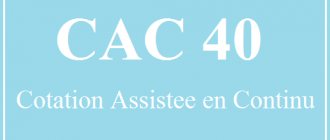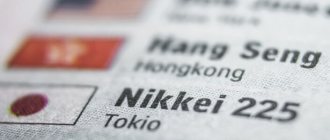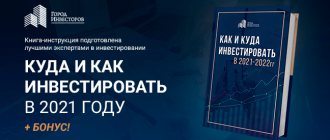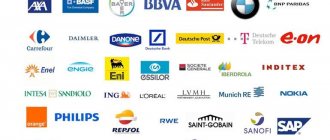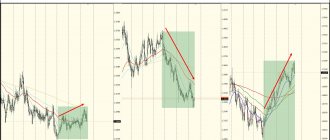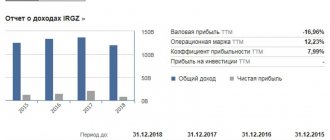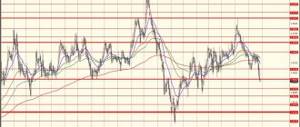Lazy Investor Blog > Stock Exchange
Stock indices of the USA, Europe, China, Hong Kong and Japan are traditionally considered indicators of the global economy. During the autumn wave of the US elections, all American indices showed stable, excellent growth, which was also picked up by European indices. However, the wave of investor optimism is gradually subsiding, and the behavior of the US and European indices is beginning to differ from each other. If S&P, NASDAQ, Dow Jones show similar dynamics (even the drawdown on May 17 due to the scandal with Trump turned out to be common), then the flagship of the European economy, the DAX index shows mixed results.
Analysts say that the US stock market is already oversaturated and will soon stop. But the European market, on the contrary, may “shoot” very soon. Especially after the current rollback. What is the structure of the DAX index and is it worth investing in it? Read on.
What is an index?
140 years ago the big problem was keeping track of the market. If a businessman showed interest in a competitor, he could easily be accused of industrial espionage. But the Dow Jones index appeared and companies began to see the overall picture of the economy.
What is an index? It shows how the largest enterprises in the country, world or industry are doing. Their success on the stock exchange is measured by a variety of indicators, resulting in pips. Therefore, when they say that the DAX30 has lost 100 points, we are talking about the weakening of the entire European market.
Which companies are included in the benchmark?
A new company is added to the index only if another company drops out (if it no longer meets the DAX criteria). This is a common characteristic for well-known index families.
There are only two requirements:
- Trade turnover.
- Capitalization of securities.
This refers to the volume of securities trading on the Frankfurt Stock Exchange and in the XETRA trading system. Moreover, the company must be represented on these sites for quite a long time. And capitalization takes into account only securities that are in free circulation. The candidate must have at least 10% free papers.
But most importantly, the company must be part of the most transparent segment of the German stock market. It's called Prime Standard.
So it turns out that the top 30 includes only “blue chips” - the richest and most reliable companies in Germany. There have been 13 manufacturers remaining within DAX since its inception. And the newest one on this list, is also the richest.
| Company name | Ticker |
| Covestro | 1COV:GR |
| Adidas | ADS:GR |
| BASF SE | BAS:GR |
| Allianz SE | ALV:GR |
| Bayer | BAYN:GR |
| Beiersdorf | BEI:GR |
| Bayerische Motoren Werke | BMW:GR |
| Commerzbank | CBK:GR |
| Continental | CON:GR |
| Daimler | DAI:GR |
| Deutsche Boerse | DB1:GR |
| Deutsche Bank | DBK:GR |
| Deutsche Post | DPW:GR |
| Deutsche Telekom | DTE:GR |
| E.ON SE | EOAN:GR |
| Fresenius Medical Care Co KGaA | FME:GR |
| Fresenius SE Co KGaA | FRE:GR |
| HeidelbergCement | HEI:GR |
| Henkel Co KGaA | HEN3:GR |
| Infineon Technologies | IFX:GR |
| Deutsche Lufthansa | LHA:GR |
| Linde | LINU:GR |
| Merck KGaA | MRK:GR |
| Muenchener Rueckversicherungs-Gesellschaft in Muenchen | MUV2:GR |
| RWE | RWE:GR |
| SAP SE | SAP:GR |
| Siemens | SIE:GR |
| Thyssenkrupp | TKA:GR |
| Vonovia SE | VNA:GR |
| Volkswagen | VOW3:GR |
The German stock index DAX (Deutscher Aktienindex) is a barometer of the German economy, the industrial heart of Europe. DAX is also popular among Russian traders, as it is calculated during the European trading session; in Russia at this time the working day is in full swing (11:00 - 19:35 Moscow time). The DAX is more popular among investors than the UK's FTSE100.
However, the most indicative, of course, is the main DAX index. The index value is calculated based on quotes from the 30 most liquid and capitalized companies in Germany. The index appeared in 1987, at the time of launch its base value was 1000 points. The index is capitalization weighted and free-float. The index weight limit per company is 10%.
In order to be included in the index, a company must have a high market capitalization, be registered in the European Union, and also have headquarters in Germany. The index includes such large companies as BMW (car manufacturer), Adidas (manufacturer of sports shoes and clothing), BASF (chemical industry), Deutsche Bank (leading German banking institution), METRO (retail company), Deutsche Post (logistics), Deutsche Borse (specializes in stock exchange transactions), Henkel (manufacturer of personal consumer goods), Volkswagen Group (car manufacturer), Siemens (mechanical engineering), RWE (energy) and others.
The DAX stock index represents the DAX family of indices, the functioning of which is provided by the German Stock Exchange (Deutsche Börse AG). Pay attention to the following categories if you follow the German economy:
• Dax German Indices – classic DAX indices for German securities; • DAX Plus Strategy Indices – indices built on the Sharpe ratio; • DAX Global International Indices – indices built on securities of various countries; • Fixed Income Indices – indices built on bonds; • Alternative Asset Classes – indices built on alternative assets – real estate and others; • Customized Indices – specialized indices created by Deutsche Börse to meet the requests of the largest funds and institutional investors with whom close cooperation has been established.
Germany and Russia are closely connected by economic relations, so the dynamics of DAX index quotes can have a noticeable impact on trading on the stock section of the Moscow Exchange.
History of creation
It all started with a journalist named Franz Mella. He worked for a famous financial newspaper, a kind of German Wall Street Journal. The publisher placed an order for the development of a convenient formula for analyzing the stock exchange. He was so pleased with the result that he invited bankers to cooperate. Thus the DAX (Deutscher Aktienindex) was born.
It was not the first German index, but quickly became the most popular. In 1999, the guys from Deutsche Börse managed to persuade their colleagues to entrust their program with calculating the index. Today DAX is calculated based on XETRA data. Today it seems natural, but 20 years ago it was a risky move.
Who is in the DAX 30?
In order to participate in the formation of the DAX 30 index, a company must meet strict requirements - operate on the local market, have a large capitalization, and be listed on the German stock exchange.
Prominent representatives who have firmly taken a position among the 30 companies in the index are Siemens, automobile giants BMW and VW, and Bayer. Also, chemical, industrial, software, and pharmaceutical companies are directly involved in the formation of the indicator. The total capitalization of the 30 companies exceeds $950 billion. As is the case with other global stock market indicators, the DAX includes a whole list of indices - bond indices (Fixed Income Indices) or indices for German securities (Dax German Indices) and so on.
At the same time, the main one in the family of indexes remains the DAX 30, which quotes blue chip shares, that is, 30 companies in the Prime and Standard categories of the Frankfurt Stock Exchange. They make up three quarters of the exchange’s trading turnover. The DAX 30 is a classic index, but it can also have modifications - for example, the DAX 100, which is based on the quotes of 100 German companies.
Types of index
DAX has thousands of variations, each to suit the needs of the individual investor. Like other analytical tools, there are indicators for industries, regions and market elements.
For example, VDAX focuses on the volatility of companies, while LDAX shows the state of the DAX30 after the end of trading.
DAXglobal Russia assesses trends in the domestic market. 50 companies after the top 30 are taken into account in MDAX, the next 50 “average” ones go to SDAX.
Deutsche Börse took everything into account and even made navigation through their products:
DAX derivative indices
The index is calculated by Deutsche Borse AG. The DAX index underlies a whole family of indicator indices, the subfamily of which includes:
- DAX German Indicates is the second name of the DAX index;
- DAX Plus Strategy Indices - indicators based on the Sharpe ratio;
- DAX Global International Indeces - indicators that include securities of companies with foreign jurisdiction;
- Fixed Income Indices - indicators that include bonds;
- Alternative Asset Classes - indicators based on alternative instruments - real estate, etc.
There are also derivatives directly from the DAX index:
- MDAX - consists of 50 companies in terms of capitalization and turnover that come after the DAX index;
- SDAX - consists of 50 companies that are listed after MDAX;
- HDAX - includes companies from the DAX and the previous 2 indices.
I also recommend reading:
How oil stocks behave during a crisis
Shares of oil companies: can you buy them already?
There are more than 10-15 such auxiliary indexes. How important is their significance for a trader? For a professional who delves into the deep essence of the stock market, analyzing each industry or working with target industry indices (funds) - important. For a private investor, I think not much. It is more important to monitor the dynamics of correlated indices in other countries. And not only the EU.
Cost and dynamics for all time
The key economic moments that Dax caught were:
- The emergence of the Internet.
- The tragedy of September 11.
- Crisis of 2008.
In response to all these events, the index behaved in the same way as other economic indicators: first it fell, then it grew.
4 major DAX30 records
- In 2002, the DAX collapsed by 44%: it was the culmination of a crisis that began with the terrorist attack in New York. That year the euro was worth the same as the dollar.
- On March 16, 2005, the DAX reached 12,000 points for the first time, the euro rose 1.5 times over the dollar.
- On October 13, 2008, the index showed an increase of 11.4% after banks received Merkel's €470 billion anti-crisis package.
- In January 2021, the Dax rose to an all-time high of 13.596 points thanks to the rise of the euro.
Calculation method
The value of the DAX is that its formula takes dividends into account. The funds reinvest dividends into the purchase of new shares - and the indicator includes this in the issuer's capitalization.
The DAX formulas themselves are complex, but are similar to the S&P500 in that they summarize companies' share prices as a weighted average. The same system, in a simplified form, is used to calculate grades at school - the result is more accurate than with a simple average.
The divisor has a coefficient that is affected by the euro exchange rate. To calculate the coefficient there is another equation, even more complex:
The formula takes into account all the little things. It has become the basis for the research of other analysts and is regularly improved.
German DAX: "What happens when the ECB stops the money pump?"
Central banks continue to "stimulate" despite the recovery in global economic growth.
The central bank's "liquidity injections" are driven by optimism. But what happens when this thinking begins to shift towards pessimism and “the money pump stops”? Author: Bob Stokes
Translation in subtitles:
There is a potential downside to the ECB's multiple bond purchases and liquidity injections.
As the May Global Market Perspective puts it:
The ECB has turned a relatively small problem of a few overleveraged banks into a systemic problem that now threatens the entire financial system.
We also looked at the ECB’s balance sheet and the main stock index of Europe’s largest economy.
The Global Market Perspective for May also showed the following chart:
The chart below compares the nominal DAX (top) with the DAX divided by the ECB balance sheet (bottom), which shows the historical nature of the liquidity injection. After more or less consistent trading throughout the 2000s, the numbers diverged in 2015 when the ECB turned on the money pump to combat Europe's sovereign debt crisis. Since then, the nominal DAX has nearly doubled, while the DAX as measured by ECB assets has fallen to a lower low in 2021.
If you are familiar with the principles of socionomics, the new science of social forecasting, you know that public sentiment pushes society to certain actions.
In other words, sentiment changes first, followed by events such as a bullish or bearish stock market and other consequences. Well, public sentiment is so optimistic today that we have this Bloomberg headline from April 20:
Central banks will continue to pump money into the economy despite the sharp rebound.
They include: the ECB, the US Federal Reserve, the Bank of Japan and 13 other institutions.
However, history shows that the public mood is changing. Fluctuations range from extreme optimism to extreme pessimism and back again - repeatedly. And as mentioned earlier, the trend changes on its own, without even needing a “catalyst.”
When the current optimistic mood is reversed and a trend towards pessimism begins, expect the public to demand that the ECB (and other central banks) turn off the tap.
Public sentiment is also reflected in the form of Elliott waves on the price charts of the country's major stock indices. Rising prices indicate a positive mood and vice versa. (The stock market tends to be the best barometer of a nation's mood because investors express their bullishness or bearishness more or less instantly through their buying and selling decisions.)
Thus, the shift towards pessimism will coincide with a decline in the DAX, as well as other stock markets around the world.
You can read our Elliott Wave analysis in the latest issue of Global Market Perspective to help you prepare for what's ahead.
Source
"Elliott Wave Theorist": in Russian
We also translate non-public articles from MyEWI, where more detailed information is published. Subscribe>>>
How to make money from rising prices?
DAX indicators are the basis for 15,000 financial products, including futures and options. I'll focus on ETFs, and here's why:
- The DAX contains the top 30 blue chips.
- ETFs replicate an index.
- Copying Dax in your portfolio yourself is time-consuming and expensive.
In 2021, Vanguard launched a new fund, the DAX UCITS ETF, to celebrate the index's anniversary. But you can only cooperate with him through a foreign broker. A total of 9 types of DAX ETFs are available for purchase in different funds.
If you contact a Russian broker or its subsidiary, they will do the same thing: they will buy securities for you from an American or European broker. Sometimes foreign companies act as sub-brokers: these details need to be clarified.
The disadvantage of such a long chain is that insurance from the broker’s country in this case is minimal. There are other points to pay attention to:
- Does the broker charge a fee for inactivity on the exchange?
- What is the commission (in percentage and dollars) for ETF trades.
- How much does it cost to withdraw funds?
In the end, the best broker is the one who:
- Not registered offshore.
- Provides 24/7 support.
- Insures investors' deposits.
And it works, of course, with utmost transparency. Therefore, the best option would be to buy ETFs on the DAX from one of the foreign brokers: IB, Saxobank or Exante.
Interactive Brokers CapTrader Exante Just2Trade
In fact, the only real major American broker who still works with Russians.
Pros:
- There is support in Russian
- Good commissions
- The deposit can be replenished with rubles (bypassing currency control)
The disadvantages include:
- Minimum deposit $10,000
- Inactivity fee
Read the review for the full set of working conditions.
German IB introducing broker for direct access to foreign markets. This is where my investment portfolio is located.
Pros:
- works with Russians
- Availability of a Russian-language version of the site
- reasonable commissions
- no fee for inactivity
- insurance under US law for $500k
The disadvantages include:
- Support exclusively in English and German
- The support service itself is poor
For a detailed review, see this post.
Another interesting broker for going abroad, and not from the IB family. Unfortunately, contracts are opened for Russians only in Cyprus.
Pros:
- Acceptable commissions
- The fact of successful verification of work by the SEC
- Russian-language website and support
On the downside:
- Cyprus jurisdiction
- Inactivity fee
Read a detailed review here. You can get a $500 bonus when opening an account here.
The company is an American subsidiary of Finam and was created to bring clients from the CIS to the American market.
Pros:
- The easiest way to open an account
- Russian-language support
- Opening an account from $200
Minuses:
- Quite high commissions
- Various additional payments
Read the fullest review here.
A Caution for Beginning Investors and Traders
And now about options and futures. You cannot trade them by simply installing the application through some website. What is being advertised on social media is not real securities, but a predatory gambling game.
The Forex currency market also has nothing to do with the stock market. This is a virtual environment that only imitates real trading. Urgent binary options also exist only in the imagination of scammers; they cannot be bought at all on the exchange.
Options and futures are contracts that fix the price or its range for an underlying asset (share). These are financial risk management tools for serious investors. They usually live only three months and are often used for speculation.
Here I remember a quote from Mark Twain:
“You should refrain from speculating on the stock exchange in two cases: if you do not have funds, and if you do have them.”
Technical analysis is just about this. It’s ridiculous to think that a complete market analysis can be provided by some algorithm. Has anyone made money like this on the stock market? Yes. They say you can win at roulette, but you can never get rich.
“What about fundamental analysis?” - you ask. Why is he better? It’s either be an economist or an investor. If you are not professionally engaged in studying economic theory, then save your money.
I only write about methods that bring real profit in the long term.
By the way, about this. Those who invested one thousand euros in the DAX30 portfolio in 1988 now have seven thousand euros: that is its return. The largest fund by volume, iShares Core, has returned 8.51% to DAX UCITS ETF holders over the past 5 years.
What is the DAX index and what influences it?
One of these indexes is the DAX index, which is responsible for Germany and the European space as a whole and displays data on averaged asset quotes of leading companies in the economy. There are 30 of them in total, and they belong to completely different industries:
- insurance business,
- telecommunications,
- developments in the field of electrical energy,
- lending and others.
For example, such world-famous brands as the BMW automobile concern, Deutsche bank, Siemens and Adidas can boast the largest volume and highest value of securities.
The world learned what the DAX index was back in 1988, when it was introduced with a reference point of 1000 points. It is now a registered trademark and a weighted index, with regularly changing criteria for participants and constantly evolving measurement methods.
However, some things remained unchanged - the DAX is influenced by political and economic factors both in its home region and in the American and Asian regions. The value of the index gradually increases over the long term, although periodically there are jumps in growth and decline tied to certain events significant for the financial world.
How can you make money on DAX indices?
Having figured out what the DAX index is, many newcomers to the field of finance wonder - what benefit do they have from this information? What are its practical applications? The answer to this is obvious - this is an excellent opportunity to make money (even for those who do not particularly understand stock trading).
There are a number of sources of income built on indices:
Investments in mutual funds and ETFs with a composition that duplicates the structure of stock indexes. If you independently compile similar portfolios, you will have to attract much larger amounts of funds. Among the disadvantages are large commissions and a high (at least for the average investor from Russian-speaking countries) entry threshold. Investing in DAX index shares with the assistance of intermediaries - brokers. The first step is to take care of opening an account with a company that will allow you to purchase securities of all companies included in the index, which only wealthy investors can afford. Since the final cost of the entire package is quite substantial. Index futures. Futures are contracts that are enforceable through monetary settlements. All participants in futures transactions undertake obligations to pay or receive the difference between the cost of transactions and the cost of executing contracts. The downside is also high capital requirements, the plus is the flexibility of this financial instrument. Forex. It is the simplest, but has its own nuances, way of earning money. Having registered with a brokerage office and opened an account, all that remains is to fund it and select the desired type of asset. The entry threshold for some intermediaries starts from $10, which makes trading on the foreign exchange market accessible to absolutely everyone. There are also a number of disadvantages - the presence of slippages, orders that do not work and other typical problems of traders often lead to loss of money. This largely depends on the broker with whom a person cooperates.
Of course, each case has its own number of nuances that novice investors need to take into account. Yes, investing in the DAX stock index initially seems like a stable and affordable option to increase your net worth. Analysis of the situation within a particular state is much simpler than the need to examine statistics, reporting and prospects of an individual corporation, plus there is good diversification of risks. Even if a couple of companies from the above-mentioned thirty suddenly decline in the value of their securities, the profit on the rest will still allow you to gain profit or at least prevent a drawdown.
But there is another side to the coin, which future investors should also be aware of. The lion's share of participants in the index, although demonstrating external stability, upon closer examination does not look so reliable. In fact, they are kept afloat by Germany's competent foreign/domestic policy and economy. No one can give 100% guarantees that in the near future some global negative changes will not occur in the Eurozone, due to which the forecast for the price of securities will turn out to be negative.
BEST FOREX BROKERS ACCORDING TO INTERFAX DATA
2007
BONUS $1500 TO YOUR ACCOUNT. | FXCOPY SERVICE | review/feedback 1998. ECN broker! CASHBASK FROM ALPARI | review / reviews 2007.
FinaCom. 15% BONUS + CASHBACK | review / reviews 1997. National Bank of the Republic of Belarus. Not for the Russian Federation! $50,000 FOR DEMO | review / reviews AND ALSO THE BEST BINARY OPTIONS BROKERS IN 2021:
Deposit from $10!
TRADE WITHOUT VERIFICATION | review/feedback Copy Deals! 10.000 FOR DEMO ACCOUNT | review/feedback
What affects the price
The German DAX shows the overall dynamics of the European market. Therefore, the factors that influence it are global. Here are a few of them:
- Company reporting. When businesses share quarterly or annual results, their stock prices change.
- Political decisions. If world powers conflict with each other, this always applies to the economy
- Economic "bubbles". This is the name for the success of some part of the economy that has no basis. When a “bubble” bursts, market growth prospects decrease.
- Changing the rules of the Deutsche Börse itself. For example, on September 24, 2018, the calculation formulas for MDAX, SDAX and TecDAX will change.
- Interest rates in the USA. The Fed controls how much it costs to borrow from the United States. If their strategy fails, Dax will lose points.
- When the euro falls, there are more transactions on the exchange, hence the dynamics of the DAX.
Forecast, analytics and prospects
Useful articles
What are portfolio investments Asset Allocation and why are they so popular?
There’s always not enough money, earn at least 20,000, at least 200,000: what to do?
Where should you keep your stash for a rainy day so you can look forward to it?
How to legally make money by insuring yourself?
The financial market speaks for me: DAX30 has become the basis for many financial instruments (mutual funds, ETFs, futures, options...). This indicates the reliability and accuracy of the indicator.
The index includes the most liquid companies. Among them, Deutsche Bank is experiencing a crisis; analysts see its future in gloomy tones. But this doesn’t matter: the rest of the top 30 corporations are successfully developing and keeping up with the times. For example, Adidas and Bayer are increasing their influence and have yet to have any major failures.
There is currently no news about a trade war between China and the United States, so the indicator regularly closes trading days with an increase of a hundred points. The conflict itself is in limbo and no one undertakes to make a forecast.
Right now, amid sanctions, the price of important exchange assets has fallen: copper and aluminum. Therefore, the German economy and the DAX are weaker today than they could be. As soon as China returns to purchasing raw materials, the situation will stabilize.
In May, everyone reported their successes to the press. As a result, the index showed growth: 30 German companies exceeded the expectations of German investors, thereby increasing demand for their shares.
The DAX gained even more points when the US Federal Reserve announced GDP growth of 2% and an increase in interest rates. This happened on July 18, 2018. If nothing changes, the index will continue to grow by 0.1-0.5%.
Sanctions, the US economy and earnings season also affected other stock indices. Since this effect was the same as on the DAX30, we can once again draw a conclusion about the accuracy of the indicator.
The history of the DAX index, calculation principle and investment prospects
DAX is the main index of Germany and, accordingly, the Eurozone, displaying the weighted average of securities quotes of leading German corporations. Calculated since 1988. Only shares that are in free circulation are taken into account, that is, the price is formed based on supply and demand. The index also includes dividend yields on stocks with the expectation that dividends are reinvested in the stock. In other words, the DAX reflects the total return on capital.
The index value is calculated based on the value of shares on the XETRA electronic exchange platform. Unlike American indices, where quotes of 100 or more companies are taken into account, the DAX includes only 30 companies covering industries:
- Insurance. Surprisingly, Allianz, a representative of this industry, occupies more than 7.5% of the index. The 1-year and 5-year quotes chart for the index flagship is optimistic;
- Chemical industry. BASF is another leading company, with about a 7% share of the index. Despite the demand for the industry's products, BASF's stock price chart is unstable. The company is highly dependent on the external market and is therefore unstable to external shocks. In 2009, after the crisis in the United States and a drop in demand from automobile concerns, the company closed 80 enterprises, and shares fell from the level of “90” to the level of “20.” From 2014 to 2021, the stock tested two strong resistance levels and two support levels. And now they are going down again. Another company in this industry, Bayer (share of about 9%) is more stable, but it is still far from its historical peaks;
- Banking and stock exchange transactions. The weak point here is Deutsche Bank. Nobody believes in the bankruptcy of such a “colossus”; the German authorities will save the bank. But constant losses and legal battles in the USA and Russia (the bank is accused of a series of frauds, ranging from manipulation of the LIBOR rate to the “Moldavian scheme”) have led to the fact that the bank’s quotes have been going downward for more than 2 years;
I also recommend reading:
What should an investor choose – Intel or AMD shares?
Intel or AMD shares: battle of giants
- and other industries: energy, telecommunications, construction, consumer goods, logistics, automotive.
The DAX basket is probably the biggest risk for a potential investor. Companies that seem stable on the outside do not look so reliable from the inside. And for now they are holding on to their faith in Germany’s stable politics and economy.
Factors influencing DAX index quotes:
- ECB policy and speeches of Mario Draghi. A striking example is the speech of the head of the ECB on June 27, which talked about tightening monetary policy in the Eurozone and curtailing stimulus programs. In 2 days, DAX quotes fell from 12,770.83 to 12,325.12;
- economic situation in a particular industry: volumes of exports and imports, entry of new products into the market, release of quarterly and annual financial statements, etc.;
- global fundamental factors characterizing the stock market as a whole. A decline in the indices of China and the United States will automatically collapse the indices of Europe.
To track index quotes, it makes sense to follow the main fundamental events (they are in the economic calendar) and monitor the reporting of companies from its composition.
Similar indexes
DAX has about 12 thousand varieties, so there will always be some overlap with the developments of other analysts. One of the popular analogues: MSCI Germany. There are also ETFs based on it.
By the way, DAX30 is often compared with Standard&Poor500 due to the fact that both indicators use a weighted average formula. In addition, they show the situation not only in the region, but also in the global financial market. The difference between the S&P500 is that the pip calculation does not include dividends.
